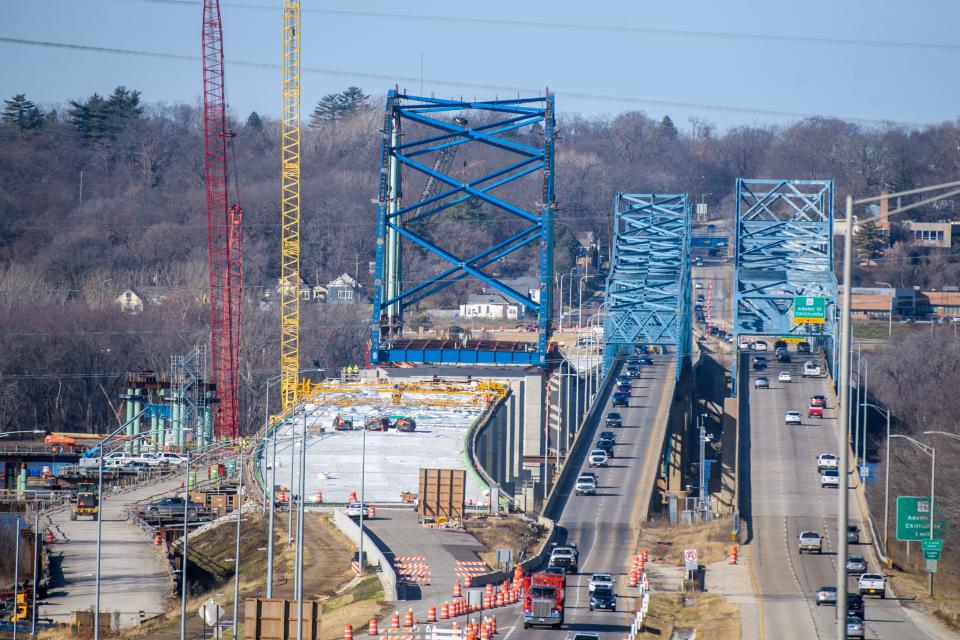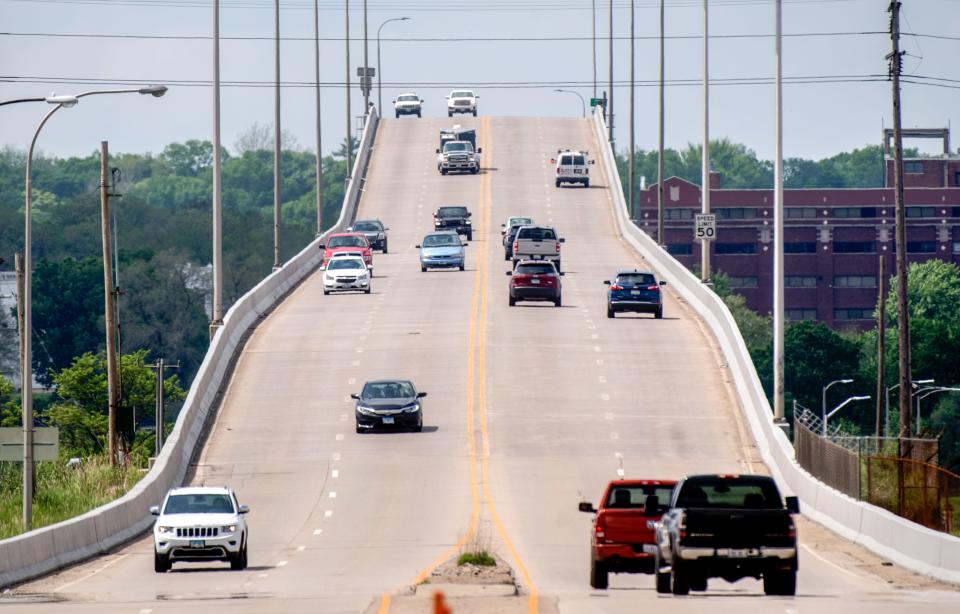After collapse of Baltimore bridge, could a similar incident happen in Peoria?
Towering over the Illinois River is the McClugage Bridge, named for the Depression-era mayor of Peoria and carrying traffic across War Memorial Drive into Tazewell County and back again since just after World War II.
In the 74 years that the bridge has been in existence, it has seen two significant improvements – the arrival of a new westward span in 1982, some 44 years after the bridge was opened and dedicated, and the renovation of the eastbound side in 2000, marred by the deaths of three ironworkers.
More: 'Lies and deceit': Hotel Pere Marquette developers sentenced to prison for fraud scheme
But nothing may compare to what comes next – the new and improved eastbound portion of the bridge, slated to open later in 2024, complete with all of the bells and whistles that come with a modern bridge: a better structure, greater capacity, a spectacular new arch and access for bicyclists and pedestrians.
For the most part, things are going smoothly on the project. But after the March 26 collapse of the Francis Scott Key Bridge in Baltimore, one question can stick in the back of the minds of Peorians: Will this bridge and others like it in Peoria be safe from a similar incident in the future?
Plenty of upgrades

The McClugage Bridge is one of several bridges across Peoria that have seen or will see upgrades in the coming years as part of the Illinois Department of Transportation's Rebuild Illinois project. Already, work has been completed on the Murray Baker and Bob Michel bridges in downtown Peoria, with the Cedar Street Bridge project getting underway last month.
While none of those bridges was necessarily unsafe, structural work was needed to ensure their viability in the future. The process of examining bridges in the state of Illinois largely sits in IDOT's purview, with the department's bridge engineer Jayme Schiff saying that most bridges are inspected every other year, with adjustments made if a bridge is in rough shape.
"In Illinois, the standard bridge inspection is every two years," Schiff said. "Bridges that are newer or in very good condition, we inspect those on a four-year interval. If bridges are in poor condition, we inspect them on a one-year interval."
Just because a bridge is in poor condition, Schiff said, doesn't exactly mean that it's unsafe. All it means is that IDOT's team of engineers looks at important elements of the bridge in order to make sure that it can continue to last.
"It's just that it's in poor condition, so we need to monitor some of the bridge elements and do a more frequent inspection on those particular items and also do more routine maintenance."
Thankfully, none of the bridges in and around Peoria qualify as being unsafe, although their conditions may vary. The McClugage Bridge, for instance, is listed by the National Bridge Inventory as being in poor condition, as is the Cedar Street Bridge, with both having structural evaluations at an "intolerable" level.

Schiff said that many bridges have a Transportation Asset Management Plan (TAMP) that gives an outline for engineers on what they need to do in order to maintain the structural condition of bridges. For the most part, this includes things like sealing of concrete surfaces, expansion joint replacement and new deck overlays.
"Based on where a particular bridge is in its life cycle, treatment will range from proactive maintenance to low-cost preservation activities to higher-cost rehabilitation treatments," Schiff said. "Once they get beyond that, then it would be a replacement project. Any immediate repairs that are needed based on inspection are performed as soon as practical."
Right at the base
Common bridge repair work doesn't exactly get at why the Francis Scott Key Bridge collapsed. Schiff said most Illinois bridges don't have the sort of protection many experts believe could have prevented the Baltimore collapse, mainly because the types of ships like the Dali – the big cargo container that collided with the base of the Key Bridge – don't often go through Illinois waterways.
"We do have some pier protection cells on some of our bridges along the Illinois and Des Plaines rivers," Schiff said. "That's in areas where the channel is very narrow, but in Illinois, on our waterways, we don't have the large cargo ships similar to the one that hit the Baltimore bridge. We have smaller barges on the Illinois and Mississippi rivers."
He did say that newer bridges, such as the eastbound side of the McClugage Bridge, are being installed with vessel collision forces in mind. A ship like the Dali may not pass through, but Schiff says that the new McClugage span will have enough protection to help if a barge were to ever collide with the base of the bridge.
"It'll be designed (so that) if a barge were to hit the bridge, the bridge would be able to handle that force," Schiff said. "There won't be any pier protection cells or fender system on the new bridge because it was designed for those forces."
More: Botulism hospitalizations linked to cosmetic procedures in Illinois, other states
Lessons learned
Schiff said that future bridges in Illinois will likely have protections to ensure that an incident like Baltimore's doesn't happen here, noting that the design code IDOT uses has evolved with the times.
"Fortunately, the design code has been updated and has matured over time," Schiff said. "Moving forward in designing new bridges, we do account for those types of impacts based on the type of ship or barge traveling on that type of river. Obviously, if you do see multiple barge hits, then you would potentially put in some sort of fender system, if needed, but with all-new structures, it's designed for those collision forces."
This article originally appeared on Journal Star: Peoria bridge safety in wake of Baltimore-bridge-collapse

